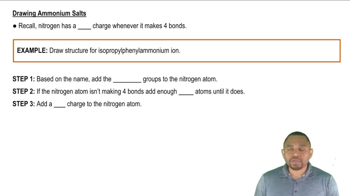Here are the essential concepts you must grasp in order to answer the question correctly.
Ammonium Salts
Ammonium salts are ionic compounds formed from the protonation of an amine, resulting in a positively charged ammonium ion (NH4+). They typically consist of an ammonium cation and a negatively charged anion, such as chloride. Understanding the structure of ammonium salts is crucial for identifying their properties and applications in various chemical contexts.
Recommended video:
Drawing Ammonium Salts Concept 2
Amines Classification
Amines are classified based on the number of carbon groups attached to the nitrogen atom. Primary amines have one carbon group, secondary amines have two, and tertiary amines have three. This classification affects the reactivity and properties of the amines, which is essential for determining the type of ammonium salt formed when they are protonated.
Recommended video:
Amine Classification Concept 1
Nomenclature of Organic Compounds
The nomenclature of organic compounds follows specific rules set by the International Union of Pure and Applied Chemistry (IUPAC). For ammonium salts, the name typically reflects the structure of the amine and the anion. Understanding these naming conventions is vital for accurately identifying and communicating the chemical nature of compounds like N-Butyl-N-isopropylhexylammonium chloride.
Recommended video:
Introduction to Organic Chemistry Concept 1
 Verified step by step guidance
Verified step by step guidance Verified video answer for a similar problem:
Verified video answer for a similar problem:



 :55m
:55m